Filipina dance costumes reflect a rich history of cultural influences and evolution.
The introduction of Spanish colonization in the Philippines brought new textiles and styles that blended with indigenous materials, creating iconic garments like the Maria Clara. This traditional costume is characterized by a long skirt, a blouse, and a scarf or shawl, showcasing the integration of Spanish and local materials. The Maria Clara remains a prominent symbol of Filipino culture and is often worn during traditional dances and celebrations.
The American colonial period further impacted fashion, leading to the terno's prominence.
During the American colonial period, the terno emerged as a popular dance costume. It consists of a butterfly-shaped sleeves and a flowing skirt, often made of lightweight fabrics and adorned with intricate designs. The terno is a unique representation of Filipino fashion, reflecting the country's cultural identity and artistic expression.
Regional variations showcase diverse cultural influences.
Regional variations in Filipina dance costumes demonstrate the country's cultural diversity. For example, vibrant Visayan hues are characteristic of costumes from the Visayas region**, often featuring bright colors and lively patterns. In contrast, the elegant styles of Luzon are marked by simplicity and sophistication**, reflecting the region's cultural heritage.
Modern designers now revive traditional elements, incorporating sustainable practices and contemporary aesthetics.
Today, modern designers are reinterpreting traditional Filipina dance costumes, incorporating sustainable practices and contemporary aesthetics. This revival of traditional elements not only promotes cultural preservation but also showcases the country's commitment to innovation and artistic expression.
Spanish Colonial Era Influences
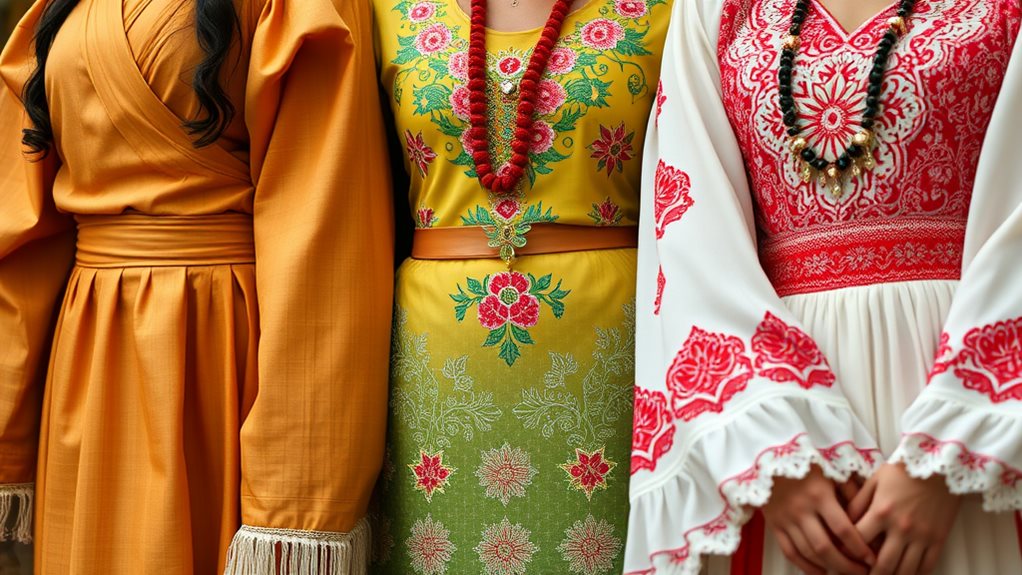
The Spanish colonial era significantly impacted the Philippines, resulting in a multifaceted influence on Filipina dance costumes. The use of Spanish textiles alongside indigenous materials like piña showcases a fascinating cultural blending.
This cultural blending is evident in the incorporation of intricate lace and embroidery techniques, reflecting colonial aesthetics. Vibrant colors and patterns, such as bright hues like red, blue, and yellow, retained a connection to the local environment and rich heritage.
To adapt to the humid climate, lightweight fabrics like silk and cotton were used.
The intricate embroidery on piña fabric is a testament to the combined skills of Spanish and indigenous influences. Ornate accessories like beaded jewelry, fans, and headpieces carried costume symbolism, reflecting social status and cultural identity.
These embellishments weren't merely decorative but served as expressions of cultural pride.
Regional variations reveal the adaptive nature of the process. The Visayan Cariñosa, for instance, demonstrates a unique style, integrating local materials and designs while maintaining a distinct cultural identity.
This wasn't a simple adoption of European fashion elements but a negotiation between colonial aesthetics and pre-existing traditions. The resulting costumes represent a complex interplay of influences, a testament to the resilience and ingenuity of Filipino artistry.
Dance costumes thus served as subtle forms of resistance and expressions of cultural pride.
The Maria Clara's Significance
The Maria Clara costume holds significant cultural importance in the Philippines, with its origins tracing back to the Spanish colonial era. The name "Maria Clara" is derived from the mestiza heroine in José Rizal's novel *Noli Me Tángere*.
The Maria Clara costume emerged around 1890 as an aristocratic version of the traditional *baro't saya*, blending indigenous and Spanish influences. It consists of four main components: the *baro* or *camisa* (a blouse), the *saya* (a floor-length skirt), the *pañuelo* (a wide scarf), and the *tapis* (a shorter overskirt). These elements together represent the idealized Filipina woman****.
The Maria Clara costume plays a prominent role in Philippine culture, symbolizing the fusion of Filipino and Spanish cultures. It is used extensively in folk dances and theatrical performances showcasing Filipino heritage****. The costume also represents the virtues and nobility often associated with Filipina women.
Its elegant design has served as inspiration for modern interpretations and variations, such as the *terno*.
The Maria Clara costume isn't just a historical artifact; it's a living testament to Filipino identity and cultural pride. It is often worn at significant events, from political gatherings to weddings.
The costume's enduring presence in Philippine society showcases its lasting cultural significance. Its cultural symbolism continues to inspire and resonate with Filipinos today, as seen in modern adaptations.
American Colonial Impact
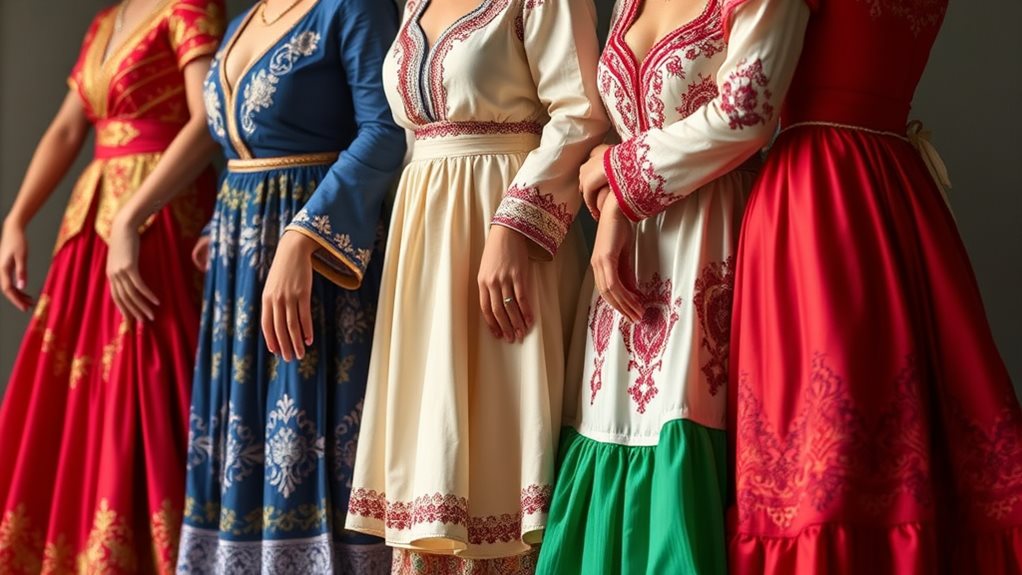
Filipino Fashion Underwent a Significant Transformation After the Spanish-American War
Following the transfer of colonial power in 1898, Filipino fashion evolved under American influence. The baro't saya, a blend of indigenous and Spanish styles, transformed into the terno, a key example of colonial fashion. The terno showcased a fusion of Filipino and American aesthetics, with broadened sleeves similar to American evening gowns and a slimmed skirt.
Traditional Clothing Adapted to American Styles and Daily Life
Traditional clothing was viewed as impractical for daily life, giving way to American styles for many Filipinos. However, traditional garments retained significance for special occasions and as a symbol of cultural resistance. The terno became a statement of Filipino identity, worn proudly alongside American clothing.
Contextual Attire Usage
| Context | Traditional Attire | American Attire |
|---|---|---|
| Daily Life | Less frequent | Increasingly common |
| Special Occasions | Predominant | Less frequent |
| Educational Settings | Alternating use | Often preferred |
| Social Gatherings | Dependent on context | Increasing use |
The Pensionado Act and Cultural Exchange
The Pensionado Act, which sent Filipino students to the US, accelerated cultural exchange. Exposure to American trends influenced clothing choices and the perception of traditional Filipino garments. This led to the strategic adoption of American clothing in certain social settings, countering negative stereotypes perpetuated at events like the 1904 World's Fair.
Regional Costume Variations
Regional variations in Filipino costumes are characterized by distinct styles across the archipelago, reflecting diverse cultural heritages.
The Visayan region features lively and playful costumes. These costumes are made from lightweight fabrics in bright hues and are often adorned with intricate embroidery.
The movements in Visayan dances blend traditional Filipino steps with Spanish influences.
Mindanao styles showcase a fusion of indigenous Muslim and Christian traditions. This fusion is influenced by Spanish and American styles, which is evident in the vibrant fabrics and metallic accessories used in their costumes.
The movements in Mindanao dances incorporate elaborate hand movements and footwork, reflecting the styles of the Tausug and Sama tribes.
Luzon is known for its elegant movements and costumes. The region's dances often feature Maria Clara gowns and barong tagalog, demonstrating a strong sense of nationalism.
The costumes are elegantly designed and colorful, showcasing Luzon's rich heritage and cultural pride.
Bicol's unique dance steps and complicated footwork involve handkerchiefs. The costumes in Bicol dances are often in vibrant colors and traditional fabrics, reflecting the region's unique cultural heritage.
Each region in the Philippines has its unique cultural elements, which are reflected in their costumes and dance styles.
Indigenous Dance Attire
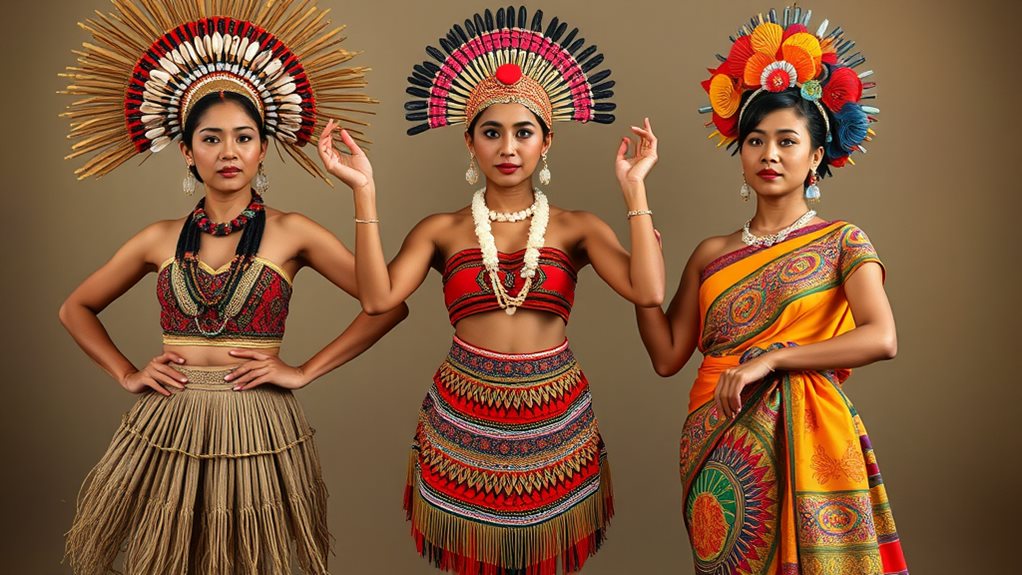
Foundational Elements of Indigenous Filipino Dance Attire****
Indigenous Filipino dance attire is characterized by simplicity, reflecting the practical needs of the humid climate. This simplicity doesn't diminish the attire's significance. Traditional attire is made from natural materials and crafted using traditional techniques, highlighting the wearer's connection to nature and cultural heritage.
Traditional Attire Components and Their Significance
The attire of men and women traditionally consists of the following components:
- Upper Body: Often bare or draped with fabric, serving multiple purposes such as practicality, ritual exposure, and body adornment.
- Lower Body: Men wear loincloths, while women wear wrapped fabric around the waist, showcasing modesty and cultural identity.
- Adornments: Necklaces, ankle bells, and face paint are used in rituals, symbolizing social status, and warding off evil.
Ritual Significance and Expression
The ritual significance of these costumes is undeniable. They're integral to ceremonies and dances, expressing community life and cultural identity. The attire represents a complex intersection of practicality, ritual, and cultural history.
Examples of Traditional Craftsmanship and Expression
- The intricately woven costumes of the Yakan tribe showcase traditional craftsmanship.
- The incorporation of bamboo in dance props demonstrates a deep connection to nature.
- The use of face paint in rituals like the *Pangsak* and ankle bells in dances like the *Singkil* highlights the strategic use of adornments in traditional dances.
Regional Variations and Cultural Expression
While the foundational elements of indigenous Filipino dance attire are consistent, regional variations exist. These variations are a testament to the rich cultural diversity of the indigenous Filipino communities.
Modern Terno Adaptations
Modern adaptations of the terno, a traditional Filipino dress, showcase a dynamic interplay between heritage and innovation**. Designers experiment with diverse fabrics like silk, satin, and lace, incorporating unconventional materials to add intriguing textures and visual variety. For instance, the use of locally sourced materials minimizes environmental impact**.
Additionally, recyclable materials are incorporated into the terno's construction to support sustainable fashion.
The traditional color palette has expanded dramatically, offering a wider range of hues and tones. Designers are no longer limited to traditional colors and can now choose from a broader spectrum of shades. This expansion allows for more intricate embellishments—beadwork, embroidery, appliqué—to enhance the terno's visual appeal.
The terno's evolution reflects a desire to reconnect with cultural heritage**. Contemporary designers** like Rajo Laurel and Michael Leyva draw inspiration from historical designs like the Traje de Mestiza and Maria Clara. These designers reimagine traditional elements with modern aesthetics, resulting in unique and modern terno designs.
Initiatives like TernoCon further showcase the terno's evolution, fostering mentorship and collaboration.
The terno continues to evolve, adapting for various occasions, from formal events to everyday wear. This adaptability reflects national pride on a global stage.
With a focus on sustainable fabrics and eco-friendly practices**, the terno has become a symbol of Filipino culture and innovation** in the fashion industry.
Contemporary Filipiniana Styles
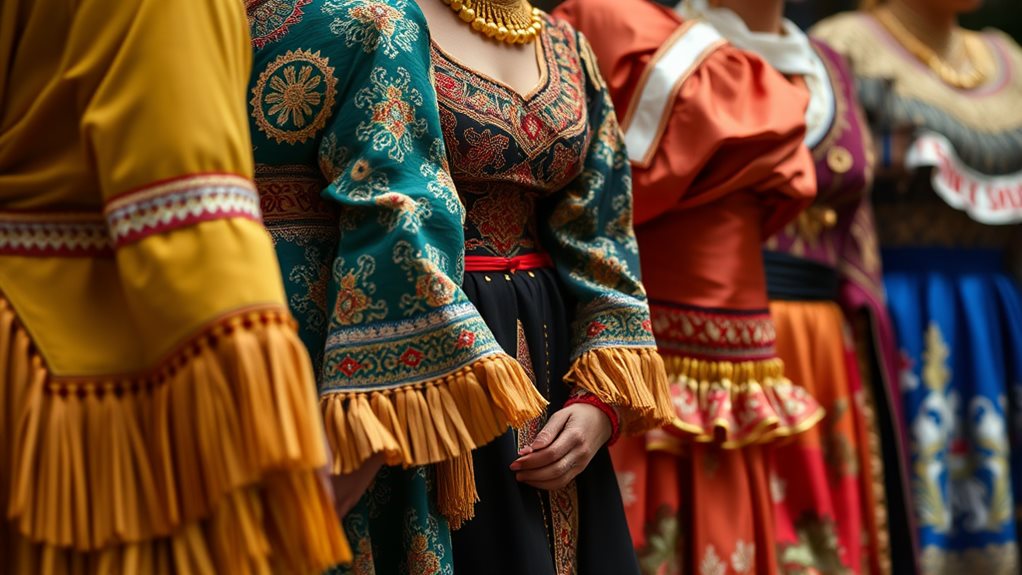
Contemporary Filipiniana Styles Blend Tradition and Modernity****
Contemporary Filipiniana styles effectively merge traditional techniques with modern aesthetics, creating clothing that's both culturally relevant and stylishly contemporary. This fusion is achieved by incorporating innovative materials like jusi and organza, as well as contemporary silhouettes, which enhance comfort and versatility.
Additionally, mixed colors and intricate embroidery set these designs apart from their traditional counterparts.
Innovative Materials and Sustainable Fashion****
The conscious integration of innovative materials with indigenous textiles supports sustainable fashion practices. This blending of old and new elevates the overall style and wearability of the clothing.
For instance, designers often combine traditional textiles with modern materials, resulting in unique and eco-friendly pieces.
Evolution of Traditional Elements
Contemporary designers cleverly fuse traditional elements with modern aesthetics, appealing to a younger generation. The iconic terno, for example, has evolved into diverse modern silhouettes, featuring streamlined designs, fitted shapes, and new weaves.
Hand-painting and beadwork add decorative flair, transforming the traditional ensemble.
Global Visibility and Widespread Appeal****
The evolution of Filipiniana has propelled it onto the global stage, achieving significant global visibility.
Beauty pageants, in particular, have been instrumental in showcasing these designs internationally. Overseas Filipinos and foreigners now frequently incorporate Filipiniana into special events, demonstrating its widespread global appeal.
Preserving Traditional Craftsmanship and Versatility
Local artisans and weavers collaborate with designers, preserving traditional craftsmanship.
This collaboration has led to a resurgence of interest in traditional fashion, both locally and internationally. Modern Filipiniana isn't confined to formal occasions; it has become versatile enough for everyday wear.
Custom options cater to both traditional and modern preferences, making this clothing more accessible than ever.
Cultural Preservation Efforts
Preserving Filipiniana's Cultural Significance
The enduring appeal of Filipiniana relies heavily on the dedicated efforts to preserve its cultural significance. Traditional costumes, like the baro't saya and barong Tagalog, have become symbols of national identity, reflecting a rich history interwoven with indigenous and foreign influences.
Costume sustainability is key to preserving these traditions. This involves understanding the artistry and craftsmanship involved in creating these garments, often passed down through generations.
Supporting Preservation Efforts
To actively participate in preserving Filipiniana, one can:
- Support community events showcasing traditional dances in their original costumes, such as the Tinikling or the Singkil.
- Encourage educational programs that teach the history and significance of Filipiniana, highlighting the cultural nuances behind the design and use of traditional costumes.
- Patronize artisans and designers who make sustainable, ethically produced costumes, promoting the continuation of traditional crafts and art forms.
- Advocate for policies that support the preservation of traditional crafts and art forms, ensuring the longevity of Filipiniana.
- Learn about the symbolism embedded within the costumes themselves, understanding the cultural context behind their design and use.
Ensuring Relevance and Accessibility
By valuing the historical and cultural context of these costumes, one contributes to their continued relevance, ensuring the vibrant traditions aren't only maintained but thrive.
Conscious engagement fosters both costume sustainability and dance accessibility, securing Filipiniana's place in the cultural landscape.
Promoting Traditional Dances
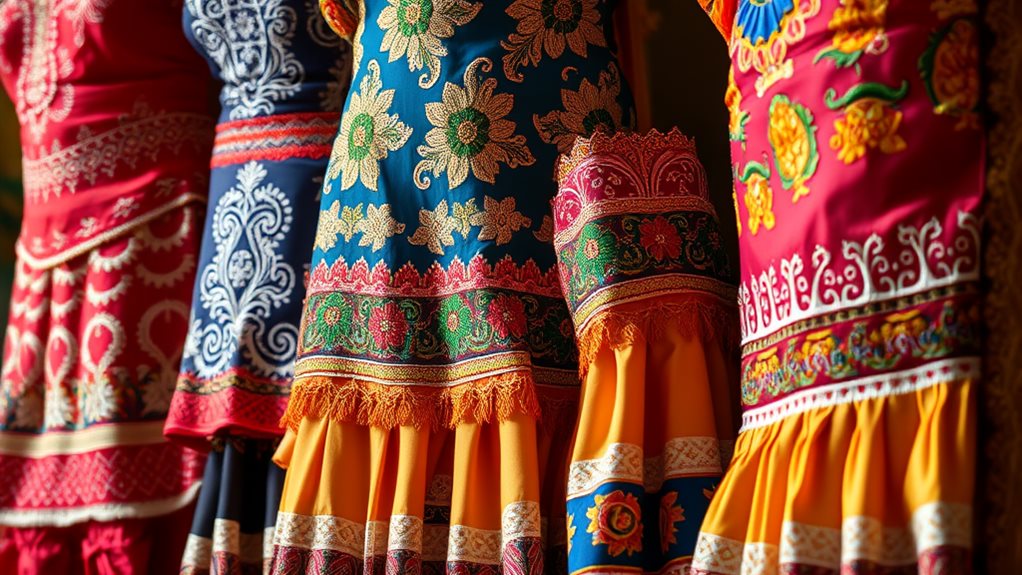
Promoting Traditional Dances
Traditional Filipino dances are preserved and promoted through various strategies. Dance festivals and community workshops are key drivers in this effort. These events showcase traditional dances like Tinikling, blending traditional and modern elements to attract a wider audience.
Festivals and Workshops
Festivals and workshops play a significant role in promoting traditional Filipino dances. Dance festivals provide a platform for showcasing traditional dances, often incorporating modern elements to increase appeal. Community workshops, on the other hand, offer in-depth training, covering the steps and historical context of the dances. Experienced dancers and experts conduct these workshops, ensuring a deep understanding of the heritage.
Educational Initiatives
Educational initiatives also contribute to the preservation of traditional Filipino dances. Institutions offer programs and workshops that teach not only the steps but also the historical context. These programs highlight the evolution of the dances, showcasing influences across different eras. By educating the public about the significance of these dances, these initiatives successfully pass traditions to future generations.
Community Engagement and Collaboration
Community engagement and collaboration fuel the promotion of traditional Filipino dances. Community gatherings and festivals provide crucial platforms for collective celebration. Events like TernoCon inspire designers, promoting both dress and dance. Social media expands the reach, sharing performances globally. Collaboration between traditional and contemporary artists creates innovative performances, integrating traditional dances with styles like breaking to attract diverse audiences.
Key Promotion Methods
| Promotion Method | Description |
|---|---|
| Dance Festivals | Showcase traditional dances, often incorporating modern elements for wider appeal. |
| Community Workshops | Offer in-depth training, covering steps and historical context. |
| Educational Programs | Teach the evolution of dances, highlighting influences across different eras. |
Cultural Identity and Heritage
Filipino Dance Costumes Reflect a Blend of Indigenous Traditions and Foreign Influences****
Filipino dance costumes have evolved over time, showcasing a unique cultural tapestry that combines indigenous traditions and foreign influences. The Baro't Saya, a traditional Filipino garment, is a product of Spanish colonization, blending European modesty with native fabrics and elements like the Tapis. This blend reflects the complex negotiation between imposed cultural norms and the persistent assertion of Filipino identity.
The Maria Clara, with its conservative design, symbolized adherence to Catholic values imposed during the Spanish era. However, its fabrics and embroidery hinted at underlying cultural pride.
The Traje de Mestiza and the Terno, which evolved later, refined the silhouette while retaining intricate embroidery and traditional textile symbolism. These garments demonstrate a continuous effort to balance foreign influence with the preservation of cultural heritage.
Key Features of Filipino Dance Costumes****
- Integration of Foreign Elements: The Baro't Saya cleverly combined Spanish modesty with native fabrics.
- Cultural Expression: The Maria Clara represented a period of cultural imposition but also resilient cultural expression.
- Refined Elegance: The Traje de Mestiza and Terno showcase refined elegance while retaining traditional roots.
- Textile Symbolism: Textile symbolism, through embroidery and fabric choice, consistently conveyed cultural pride.
Modern Revival of Traditional Garments
Modern designers revive traditional garments, fostering cultural heritage while embracing modern sensibilities. This revival highlights the skillful integration of foreign elements into the very fabric of Filipino dance costumes.
The enduring legacy of these garments lies not just in their aesthetic appeal but also in their ability to narrate a story of adaptation, resilience, and the continuous reaffirmation of cultural identity.
Questions and Answers
What Fabrics Were Traditionally Used in Making Filipiniana?
Filipiniana traditional clothing typically utilized indigenous materials for its fabric. Cotton, abaca, and piña were the primary textiles used in making Filipiniana attire. These native textiles were common choices due to their availability and durability. Abaca, for instance, is a strong fiber derived from the abaca plant, making it suitable for creating sturdy fabrics. Piña, on the other hand, is a delicate and soft material obtained from pineapple leaves, often used for more elegant and intricate designs.
How Did Men's Attire Evolve Alongside Women's?
Men's attire evolved over time, mirroring cultural influences throughout history. This parallel development is evident in the evolution of the Barong Tagalog, a traditional Filipino garment. The Barong Tagalog's design and fabric changed in response to various cultural and historical events, mirroring the evolution of women's attire in the Philippines.
Historical events significantly influenced men's fashion. For example, during the Spanish colonization of the Philippines, the Barong Tagalog was designed with a more Westernized style, featuring a collar and buttons, to reflect the cultural influence of the colonizers. This change in men's attire mirrored the adoption of Western-style clothing by Filipino women during the same period.
Cultural exchange also shaped men's fashion. The Barong Tagalog's embroidery and fabric designs, for instance, were influenced by Chinese and Islamic cultures, which traded with the Philippines. This cultural exchange is also evident in the evolution of women's attire in the Philippines, with the incorporation of Chinese and Islamic elements in traditional garments.
Men's attire continues to evolve, reflecting changing cultural values. Today, the Barong Tagalog is a symbol of Filipino heritage and is often worn on special occasions. Its evolution alongside women's attire demonstrates the dynamic and interconnected nature of fashion and culture throughout history.
What Are Some Common Accessories Worn With Dance Costumes?
Common dance costume accessories include headpieces, jewelry, and ornate fans. These items can greatly enhance the overall aesthetic of the costume. For example, headpieces may be simple or elaborate, depending on the type of dance. Jewelry can range from simple earrings to intricate necklaces and armlets. Ornate fans, on the other hand, are often used in traditional or cultural dances to add a touch of elegance.
Embellishments on sleeves, pañuelos, and tapis are also popular. These items can add an extra layer of visual interest to the costume. Embellished sleeves, for instance, can feature intricate designs or patterns that match the rest of the costume. Pañuelos, which are traditional scarves, can be worn around the neck or on the head, adding a pop of color and texture. Tapis, or decorative panels, can be attached to the costume to create a dramatic effect.
In some cases, bells and even weapons may be worn as part of the costume. These items can serve a functional purpose, such as creating musical sounds or adding a dramatic element to the performance. Bells, for example, can be attached to the ankles or wrists to create a rhythmic sound. Weapons, on the other hand, may be used in traditional or cultural dances to represent strength or bravery.
Are There Any Significant Color Symbolism in Costumes?
Colors hold cultural significance in Filipino costumes. These meanings reflect tribal identity, spiritual beliefs, and social status. For instance, the T'boli people of southern Philippines use red and yellow in their traditional clothing to signify their connection to nature and the spirits that inhabit it. The Ifugao people, known for their skilled farming practices, wear earth-toned costumes to symbolize their link to the land. Over time, indigenous and colonial influences have blended together to create the rich color meanings seen in Filipino costumes today.
How Has Globalization Impacted Modern Filipiniana?
Globalization has significantly impacted modern Filipiniana by blending traditional elements with global trends. This cultural fusion is evident in contemporary designs, such as the incorporation of Western fabrics and styles into traditional Filipino attire like the barong tagalog and terno. The use of modern materials and techniques has also influenced the evolution of Filipiniana, resulting in innovative and evolving styles. For instance, designers now use computer-aided designs and 3D printing to create intricate patterns and accessories, showcasing the fusion of traditional craftsmanship with modern technology.